Source: Mr. Bridge by Andrew Kambites
You may have read that it is correct to lead passively against 6NT, but actively against a suit slam. This really is a simplification. As always, it depends on the bidding. The question to ask is whether your potential tricks are likely to run away if you defend passively. That tends to depend on whether there are long suits about. Consider your lead from this hand after auctions A, B, C and D.

After Auction A, I would expect partner to have very little. Neither North nor South has suggested holding any long suits, therefore, it is quite likely that declarer will have to rely on generating some club tricks. Having opened 2NT, South will have most of the high cards and you must hope that South has the ![]() A and needs a club finesse. A passive lead is called for, which gives a choice between the red suits. The longer one is likely to be safer so I would suggest leading the
A and needs a club finesse. A passive lead is called for, which gives a choice between the red suits. The longer one is likely to be safer so I would suggest leading the ![]() 7 (second highest from a suit without a picture card). In Auction B, North has shown at least five diamonds and South has shown at least five spades (for his jump to 2
7 (second highest from a suit without a picture card). In Auction B, North has shown at least five diamonds and South has shown at least five spades (for his jump to 2![]() ). Your five small diamonds suggest his diamonds are solid. He may well have 12 easy tricks by driving out the
). Your five small diamonds suggest his diamonds are solid. He may well have 12 easy tricks by driving out the ![]() A, therefore, I think you need to try to set up a club trick. There is a good case for leading the
A, therefore, I think you need to try to set up a club trick. There is a good case for leading the ![]() 3. Partner just might have the
3. Partner just might have the ![]() Q, or alternatively the layout could be:
Q, or alternatively the layout could be:
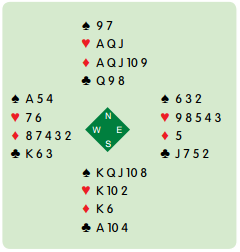
Once declarer drives out the ![]() A, he has more tricks than he needs without touching clubs. If you lead a club, he has a guess at trick 1. If he guesses that you have underled the
A, he has more tricks than he needs without touching clubs. If you lead a club, he has a guess at trick 1. If he guesses that you have underled the ![]() J rather than the
J rather than the ![]() K, he will play low from dummy. Partner’s golden
K, he will play low from dummy. Partner’s golden ![]() J will force out the
J will force out the ![]() A and you have the
A and you have the ![]() K to cash when you come in with the
K to cash when you come in with the ![]() A. Auction C has resulted in a suit contract but apart from the fact that North/South have a 4-4 trump fit, there is no evidence of any long suits. I would make a passive lead, perhaps a trump to cut down any cross ruffing. You hope declarer has to take a club finesse into your hand. In Auction D, South has at least five hearts and North has at least five spades (for his jump to 2
A. Auction C has resulted in a suit contract but apart from the fact that North/South have a 4-4 trump fit, there is no evidence of any long suits. I would make a passive lead, perhaps a trump to cut down any cross ruffing. You hope declarer has to take a club finesse into your hand. In Auction D, South has at least five hearts and North has at least five spades (for his jump to 2![]() ). Again, declarer is likely to make 12 tricks without touching clubs, so you should try to build a club trick by leading the
). Again, declarer is likely to make 12 tricks without touching clubs, so you should try to build a club trick by leading the ![]() 3. If you are lucky, the layout might be:
3. If you are lucky, the layout might be:
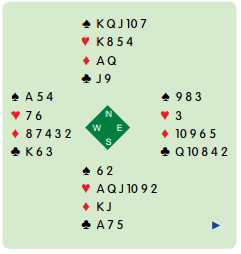
If these examples prove anything, it is that each case must be considered on its merits. Of course, I am assuming your opponents have bid sensibly. If you know your opponents are likely to have bid absurdly, my logic may not apply. I am well aware that many readers might feel horror about underleading a king against a slam. For Auctions B and D, where I have advocated underleading the ![]() K, I have given potential layouts. You might feel that you would be extremely lucky to find such a layout. This is true, but the bidding has told you that unless you build a club trick, your
K, I have given potential layouts. You might feel that you would be extremely lucky to find such a layout. This is true, but the bidding has told you that unless you build a club trick, your ![]() K is likely to be waste paper so you are hardly risking much. You might also argue that partner might turn up with an unexpected full blown trick. That would indeed be a bonus and if that is the case, it probably hardly matters what you lead: his trick and your
K is likely to be waste paper so you are hardly risking much. You might also argue that partner might turn up with an unexpected full blown trick. That would indeed be a bonus and if that is the case, it probably hardly matters what you lead: his trick and your ![]() A will beat the contract anyway.
A will beat the contract anyway.
Leading aces against a slam
I can now almost hear you asking, ‘Do I lead an unsupported ace against a slam?’ It tends to be wrong if an opponent has shown strength in the suit. In an unbid suit, you must ask yourself whether it is likely to disappear if you don’t cash it. A horrible decision faced a Welsh player in the final hand of the 2000 Camrose (the home international tournament with England, Scotland, Wales, Northern Ireland and the Republic of Ireland). Wales were playing the Republic of Ireland. If he found the opening lead to beat 6NT, Wales would win the Camrose for the first time ever. Would you cash your ![]() A?
A?
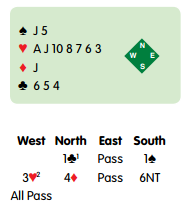
1 Strong and artificial. Usually 16+ points.
2 Weak jump overcall.
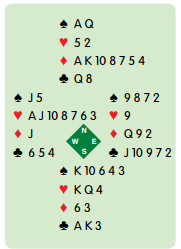
Knowing that North had strong diamonds and South had at least five spades, West cashed his ![]() A. That gave declarer 12 tricks: five spades with the
A. That gave declarer 12 tricks: five spades with the ![]() J dropping, two hearts, two diamonds and three clubs. Any lead apart from a heart would have left declarer at the mercy of the diamonds. All I can say is, ‘There, but for the grace of God go I.’ No reader will ever face a more important opening lead, or with more heartbreaking consequences when his reasonable choice turned out to be wrong. Looking back to the earlier leads, after Auctions A, B, C and D, in no case would cashing the
J dropping, two hearts, two diamonds and three clubs. Any lead apart from a heart would have left declarer at the mercy of the diamonds. All I can say is, ‘There, but for the grace of God go I.’ No reader will ever face a more important opening lead, or with more heartbreaking consequences when his reasonable choice turned out to be wrong. Looking back to the earlier leads, after Auctions A, B, C and D, in no case would cashing the ![]() A be a good idea. This is particularly true after Auctions B and D. In each case, an opponent has shown long, strong spades and all that cashing the
A be a good idea. This is particularly true after Auctions B and D. In each case, an opponent has shown long, strong spades and all that cashing the ![]() A would do is set up his suit. As with a lot of what I have said about opening leads, I cannot give you a magic formula. I can try to show you the right thought processes, but at the end of it, you can give a difficult lead problem to a panel of experts and find strong disagreement.
A would do is set up his suit. As with a lot of what I have said about opening leads, I cannot give you a magic formula. I can try to show you the right thought processes, but at the end of it, you can give a difficult lead problem to a panel of experts and find strong disagreement.
Lightner Doubles
What do you lead with this West hand after the auction below?
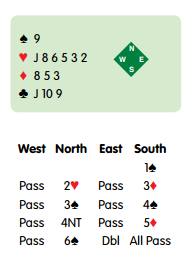
Your opponents have bid freely and confidently to 6![]() and partner has doubled. A double of a freely bid slam by the defender not on lead is not made simply to increase the penalty. Partner is asking for an unusual lead; this is called a Lightner double. Your normal lead without the double would be the
and partner has doubled. A double of a freely bid slam by the defender not on lead is not made simply to increase the penalty. Partner is asking for an unusual lead; this is called a Lightner double. Your normal lead without the double would be the ![]() J, the unbid suit. Partner is saying that is not what he wants and the most likely reason is that he has a void and wants to ruff. Looking at your hand in the light of the bidding, it is not hard to work out that he is void in hearts.
J, the unbid suit. Partner is saying that is not what he wants and the most likely reason is that he has a void and wants to ruff. Looking at your hand in the light of the bidding, it is not hard to work out that he is void in hearts.
